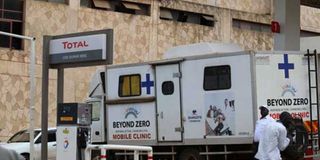Use broadband for universal healthcare

Beyond Zero mobile clinic van in Kisii town on November 22, 2016. PHOTO | BENSON MOMANYI | NATION MEDIA GROUP
What you need to know:
Kenya has among the best broadband coverage in Africa with upwards of 75 per cent of the population covered by mobile broadband and fibre broadband growing rapidly.
Digital technology is also crucial in collecting and analysing timely data to improve the efficiency and quality of care delivered.
Very few health facilities are using broadband; neither are patients using it to access health information and services.
One of the most talked-about issues facing Kenya today is healthcare.
It was by design that President Uhuru Kenyatta included universal healthcare in his ‘Big Four’ agenda. The Kenya Private Sector Alliance also found it fitting to convene the Kenya Health Stakeholders Forum, whose theme was ‘Accelerating Progress Towards Realisation of Universal Health Coverage in Kenya’.
But we need to take the conversation beyond healthcare. Kenya is acclaimed as a major technology hub that is competing with globally renowned ones, even earning Nairobi the nickname “Silicon Savannah”.
It is an obvious advantage that sits in plain sight which, if taken up, can leapfrog the universal healthcare dream.
Kenya has among the best broadband coverage in Africa with upwards of 75 per cent of the population covered by mobile broadband and fibre broadband growing rapidly.
STRONG BUSINESS
And there would be a strong business case for extending the broadband coverage quickly. Research shows that preventative healthcare saves up to 14 times the amount that is spent on curative healthcare.
With much of its population youthful, Kenya can use a systematic and nationwide approach to health promotion campaigns using digital platforms — from SMS campaigns to apps to chat-based helplines to seed out self-help information on healthcare.
With a greater share of the health burden coming from non-communicable diseases, which often face the elderly, digital information is a low-cost way of providing education on how to keep healthy as well as manage existing health issues.
After prevention, the health continuum starts with diagnosis and then treatment.
We can use the existing health workforce more efficiently through remote training and consultations, as well as remote diagnosis using information from connected medical devices.
COST-EFFECTIVE
With so many new forms of diagnosis possible using apps on smartphones, or simple and cost-effective accessories that can be plugged into a smartphone, there is no reason to delay the use of these latest technologies.
On financing, the focus must not only be on getting or spending more money but using our existing resources more efficiently to get better health outcomes at less cost.
Health insurance systems will also be crucial, and digital systems are necessary to recruit members, verify details and provide rapid payments and reimbursements. With large amounts of such data, algorithms can predict and improve the management of resources, quality of services and financial models whilst reducing administration costs of the health and insurance systems.
Digital technology is also crucial in collecting and analysing timely data to improve the efficiency and quality of care delivered.
Beyond the existing low-cost cloud-connected diagnostic devices and software, broadband technologies can reduce fraud in procurement or sale of health products and the supply chains that ensure health products are kept cold and are always in stock.
GOOD DATA
Health infrastructure also needs to be broadened to not just include buildings, equipment and beds but also explicitly recognise the need for IT and broadband infrastructure, which needs to be seen as critically and fundamentally important as electricity and provided to all health facilities.
Service delivery can also be improved through more efficiency and a culture change — based on data that focuses on performance and outcomes and not just activities and resources.
Leadership and governance can leverage the use of good data to better measure, monitor and manage staffing and facilities; allocate and incentivise appropriate activities; and ensure appropriate accountability that ensures high productivity and quality.
Such data is also critical to health research.
HEALTH INFORMATION
Very few health facilities are using broadband; neither are patients using it to access health information and services.
It would not be expensive to provide broadband in the two-thirds of health facilities within range of a signal or to better communicate with staff, volunteers and patients over such networks to prevent and manage healthcare better.
If we do this, we can make better use of ongoing government investments in broadband infrastructure and then invest in reaching the health facilities and patients not yet covered.
Mr Lane is the director, public affairs, at Huawei Technologies. [email protected]





